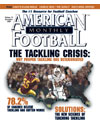AMERICAN FOOTBALL MONTHLY THE #1 RESOURCE FOR FOOTBALL COACHES
Article CategoriesAFM Magazine
|
The Tackling CrisisWhy Proper Tackling has Deteriorated with Timeby: Mike Kuchar Senior Writer, American Football Monthly © More from this issue As coaches, we spend countless hours and plenty of dollars sitting in clinic talks on the zone option or the odd-stack defense. These scheme-driven talks seem to motivate us more than anything. We shell out bucks on DVD’s about the most innovative offensive scheme or blitz-busting defense. After a loss, it’s never the scheme that bears the brunt of the loss – it’s fundamentals. “We didn’t tackle well.” If all of football comes down to blocking and tackling, then why are offenses doing a better job of blocking and defenses a poorer job of tackling? We already know how important tackling is, yet when it comes to pure teaching time during the season, it’s the scheme that usually captures most of our attention. It is a problem, and one that needs to be addressed not just in the regular season, but in spring ball and winte....The full article can only be seen by subscribers. Subscribe today!
|
|
|||||||
| HOME |
MAGAZINE |
SUBSCRIBE | ONLINE COLUMNISTS | COACHING VIDEOS |
Copyright 2025, AmericanFootballMonthly.com
All Rights Reserved





